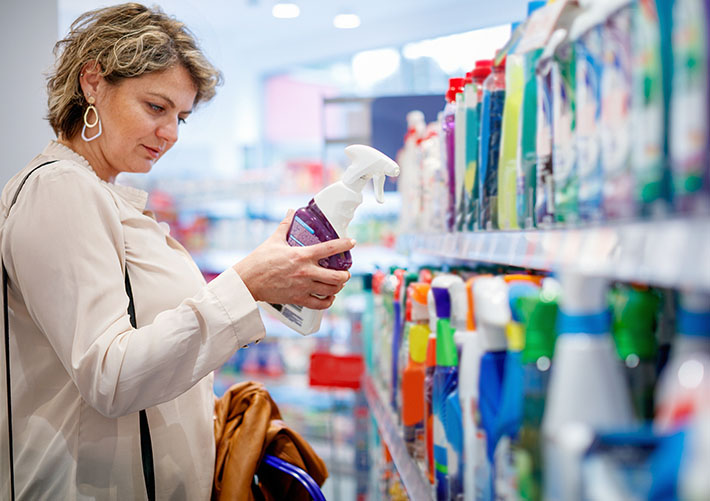
Standards Address PFAS in Everyday Products
You may not know what per- and polyfluoroalkyl substances (PFAS) are, but chances are good that you’ve encountered them millions of times in your life. After all, these chemicals are added to just about all types of consumer products, allowing them to resist heat, oil, grease, and water.
They’re in nonstick cookware, water-resistant rain jackets and tents, stain-proof carpets and upholstery, personal-care products like shampoo and makeup and much more. The media has dubbed them “forever chemicals,” meaning they never really go away without remediation. For that reason, trace levels of them can even be found in drinking water almost everywhere in the world.
“We've been using these compounds for 70-plus years in everything, so they are everywhere,” says Rock Vitale, co-chair of the subcommittee on per- and polyfluoroalkyl substances (F15.81) and founder of environmental consulting firm Environmental Standards, Inc. “There was a study that found there are only two places on the planet that do not exceed the PFAS quadrillion [PPQ] Health Advisory Limit [HAL] that the U.S. Environmental Protection Agency [EPA] recently advanced. In fact, in most places, rainwater exceeds that EPA HAL.”
READ MORE: The Fight Against PFAS
This situation has created an interesting dilemma for regulators, he says. Global society has benefited from these compounds but being exposed to them is harmful. Current regulations are increasingly concerned with PFAS exposure in drinking water but what about everything else? Food, beverages, almost everything in society involves some level of PFAS exposure. Consumer products represent the next frontier.
ASTM International has long maintained standards to address environmental measure and exposure to PFAS, but over the last decade, there has been an emerging need to pay closer attention to PFAS levels in consumer products. The result is the F15.81 subcommittee, part of the committee on consumer products (F15).
“What makes consumer products different from environmental samples is that, with water, you are just looking at the sample and preparing it in certain ways to be able to measure any PFAS in it,” says subcommittee co-chair Jeff Stull. He is with International Personnel Protection, which consults on worker safety equipment. “But with a consumer product, we're usually talking about a wide variety of items that can be made of different kinds of materials. There are different practices by which those materials can be extracted or prepared to measure PFAS and they're not trivial.”
The new subcommittee will work to provide manufacturers and users with standardized approaches to help them measure PFAS in different types of consumer products. Part of this new effort is the result of changing science behind how PFAS chemicals are detected and classified. What was once a list of over 6,000 compounds has been recently been proposed to include as many as 12,000, all fitting under the umbrella of PFAS.
“There is very little that’s similar about these compounds from an exposure or toxicity standpoint other than the fact that they all contain fluorine,” says Vitale. “From small carbons to gargantuan carbons, but if it contains fluorine lately someone is calling it a PFAS compound.”
Both state and national regulatory authorities are moving toward specific requirements for consumer products related to PFAS. Although it’s not practical to look for over 12,000 individual PFAS compounds in consumer products, there are emerging total organic fluorine (TOF) analytical methods that can be used as a proxy for total PFAS. It’s an evolving area of discovery that is calling for improved testing methodology.
Right now, there are no standard methods for measuring PFAS in consumer products. There are extraction methods and leaching methods, but they are variable and lead to different results. Are we testing for specific PFAS or total organic fluorine levels? How quantitative do we need to be in our testing? What are the regulations going to look like going forward? The new subcommittee will be working to create test methods to standardize and address these different concerns.
Stull says he hopes that the first guide from the subcommittee will be “more than just a collection of methods or practices or techniques. While that would be valuable to the industry, the subcommittee is also aiming to include aspects related to the limitations of test methods in the proposed standard so that a regulator or a consumer group or a manufacturer can understand how to properly apply the method and what it can and can't do,” he says. “Part of that process is defining why you are testing in the first place. Are you trying to understand what your product might have in it? Are you trying to meet a regulatory limit? Are you a consumer group worried about exposure? All of those considerations can call for different use cases that will guide the subcommittee’s work.”
“The fact is, PFAS is in everything we use, anything with a shiny surface,” Vitale says. “PFAS manufacturers have been successful because they've created products that have benefited society. But more and more of them are beginning to pull back because they're reading the writing on the wall. Fluorochemistry is going to be a thing of the past just as soon as it's possible to do so.”
Tim Sprinkle is a freelance writer based in Colorado Springs, Colorado. He has written for Yahoo, The Street, and other websites.
 SN Home
SN Home Archive
Archive Advertisers
Advertisers Masthead
Masthead RateCard
RateCard Subscribe
Subscribe Email Editor
Email Editor